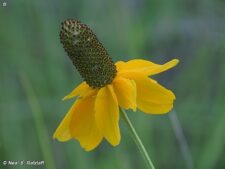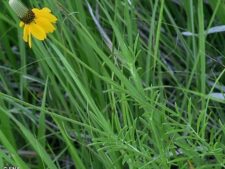
This native perennial has a single stem, or several 1-2 feet tall. It comes in two color forms (see under Comments below). The alternate leaves are divided, sometimes incompletely, into 5-9 opposite segments. These are usually linear to lance-shaped, but can be quite unequal in size and shape (D). Single flower heads are on long stalks rising well above the leaves. The characteristic columnar structure holding the tiny fertile disk flowers is 1 1/2 inch long by less than 1/2 inch in diameter, its gray-green color transforming to a deep brown as the flowers mature (B,C). From 4-11 showy, drooping petal-like ray florets surround the base of the column.
Found on drier prairie sites, flowering mainly in June and July, occasionally later. At Neale Woods, this color phase is uncommon in the Nebraska Prairie restoration.
The flowers in our local native prairies have yellow ray florets. The red and purple variants in Nebraska Prairie, sometimes called “Mexican hat” originate from seeds used in the restoration (A). The Oglala made a tea from its leaves and cylindrical heads.
Other common names include Long-Headed Coneflower and Timble-Weed.
The content of NatureSearch is provided by dedicated volunteer Naturalists of Fontenelle Forest who strive to provide the most accurate information available. Contributors of the images retain their copyrights. The point of contact for this page is: Neal Ratzlaff.



